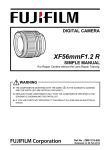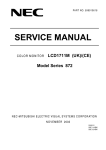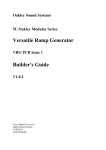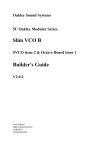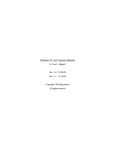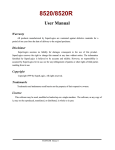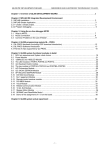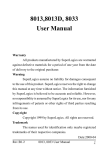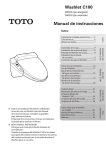Download Model: ADC-x/DIG-x
Transcript
Model: ADC-x/DIG-x RS-232 / RS-485 Data Acquisition Digital I/O v2.2 Firmware Integrity Instruments SuperLogics SuperLogics 94 Falmouth Road Newton, MA 02465 USA Phone: (617) 332-3627 Fax: (617) 332-4687 Web: www.SuperLogics.com 1 SuperLogics ADC/DIG User’s Manual Table of Contents Introduction I/O Module features .................................................................................. Quick Start - using Windows Hyperterminal .............................................. 3 4 Communications RS-485 and RS-232 Packet Description .................................................... 6 Commands and Responses Command & Response Table .................................................................... Command & Response Examples RS-232 Interface ................................... Command & Response Examples RS-485 Interface ................................... Analog Control Nibble .............................................................................. 7 8 9 10 Module Configuration DIP Switch and Jumpers ........................................................................... EEPROM Map .......................................................................................... 11 12 Modes of Operation Polled Mode .............................................................................................. Timed/Async Mode ................................................................................... Continuous Mode ...................................................................................... 13 13 14 PCB Details Board Illustration ...................................................................................... IC Description & LED Operation .............................................................. 17 17 Connector Pinouts Digital & Analog Pinout ............................................................................ Power & Communications Pinout .............................................................. RS-232 Cabling ......................................................................................... 18 19 20 Digtial I/O Technical Info Digital I/O Specifications and Control ....................................................... PWM ........................................................................................................ 21 22 Analog Input Technical Info Analog Specifications ................................................................................ Voltage References & Charge Pump Resistor ............................................ Analog Voltage Sampling & Conversion ................................................... Analog Current Sampling & Conversion .................................................... 2 23 23 24 25 SuperLogics ADC/DIG User’s Manual Introduction - Features Welcome to the wonderful world of SuperLogics I/O modules. We offer two different types of I/O module lines: ADC-x and DIG-x. Each module is available with two different serial interface types: RS-232 and RS-485. All modules use exactly the same PCB populated with different ICs dependent on the interface and Analog Input requirements. I/O Module features: MPU: Microchip PIC16C65 EEPROM: Microchip 25C040 MPU Clock: 7.3728 Mhz Interface: RS-485 (multidrop up to 255 nodes) or RS-232 (single ended) Baud: 9600, 19200*, 57600, 115200 (DIP switch selectable, *=default) LED: Bicolor diagnostic LED Watchdog: MPU has built-in watchdog timer POR: MPU contains timed Power On Reset circuitry Brownout: MPU brownout detection ciruictry built-in Temperature: 0°-70°C (32°-158°F) Extended temperature version available PCB: FR4 Power: 7.5Vdc - 30.0Vdc, approx. 50 ma. Transient: ZNR surge supression on +V power input TransZorb protection on RS-485 data lines 485-25A RS232-RS485 converter RS-232 Full duplex Host Controller Address: 0 3 wire 50” max. ADC-x 12 bit analog acquisition 16 bit digital I/O Peripheral Module Address: 1 ADC-x 12 bit analog acquisition 16 bit digital I/O RS-485 multi-drop 1 pair wire 4000”+ DIG-x 16 bit digital I/O Peripheral Module Address: 2 Up to 255 modules! 3 SuperLogics ADC/DIG User’s Manual Quick Start So, you’re in a hurry? Let’s see if we can help. You need the following: • HyperTerminal program (Windows 95/98 or Windows NT) • An open COMPORT on your PC • Power supply (we suggest a +9Vdc wall wart) • A cable to connect your PC to your I/O Module (See PCB Details section for pinout) • If you have an RS-485 interface, you need a 485-25E converter. Make these DIP switch settings SW1: OFF SW2: ON RS-232 or OFF RS-485 SW3: ON SW4: OFF Step 2 Launch the HyperTerminal program The HyperTerminal program is found under the Programs - Accessories folder. Double click on the Hypertrm.exe icon to launch the program. HyperTerminal program configuration 1) Create a new connection named “Integrity” 2) Select your Comport (COM2 in the example) 3) Set COM Properties: 19200 baud, 8 data bits, No parity, 1 stop bit, Flow control None Step 3 Step 1 19200 4 SuperLogics ADC/DIG User’s Manual Quick Start HyperTerminal program configuration cont. 4) Under the File menu, select Properties, click on the Settings tab, and adjust the ASCII Setup settings for “Echo typed characters locally” and “Append line feeds to incoming line ends” Your First Command Now that you have a HyperTerminal session running, you can start typing. After your first command, see Commands and Responses section for more commands. RS-232 • Type letter V and the Enter Key • You should see V22 on the screen RS485 • Type letters 0100V and the Enter Key • You should see 0001V22 on the screen Step 4 5 SuperLogics ADC/DIG User’s Manual Communications The SuperLogics models ADC-x and DIG-x support both RS-232 and RS-485 communications interfaces. Each interface type uses simple ASCII commands. A carriage return (decimal code 13 or Hex code 0x0D) marks the end of a data packet. RS-232 Interface: • RS-232 operates Full Duplex • RS-232 modules can enter Continuous mode whereby the module is configured via EEPROM settings to continuously communicate with the host computer to output its current Digital, Counter or Analog readings. RS-232 Command Format Command/Response ASCII CR carriage return 13 (0x0D hex) RS-485 Interface: • RS-485 operates Half Duplex • Each module (node) on the bus has a unique Address 1 to 254 (0x01-0xFE hex) • We use the latest Linear Technologies RS-485 bus drivers (LTC1487) allowing up to 255 nodes on the RS-485 multi-drop bus • Address 0 (0x00 hex) is reserved for the Host controller • Address 255 (0xFF hex) is reserved for Broadcast messages - accepted by all modules on the RS-485 bus. RS-485 Packet Format Destination Address xx Source Address xx Command/Response ASCII x = ASCII Hexadecimal Address 0x00 Address 0x01-0xFE Address 0xFF Host Device (IBM-PC, micro-controller, etc.) I/O Module Address Broadcast Address (used to configure an I/O Module) 6 CR carriage return 13 (0x0D hex) SuperLogics ADC/DIG User’s Manual Firmware v2.2 Command/Response Command and Response The following table illustrates the SuperLogics I/O module commands and responses. NOTE * All numeric data is represent as ASCII Hexadecimal integers (value x/y in the table) * If a module receives an illegal or improperly formatted command, Error Response is sent. * All ASCII characters are CASE SENSITIVE (use all capital letters!) Command Sent by Host Response Sent by I/O Module Description V Vxy Firmware version x.y I Ixxyy Input digital port status xx = PORT1 (PORTB) yy = PORT2 (PORTD) Also returns current output port status Oxxyy O Output digital port: xx = PORT1 (PORTB) yy = PORT2 (PORTD) Txxyy T Set digital direction: xx = PORT1 (PORTB) yy = PORT2 (PORTD) bit set(1) = Input, bit clear(0) = Output G Gxxyy Get current digital direction: xx = PORT1 (PORTB) yy = PORT2 (PORTD) bit set(1) = Input, bit clear(0) = Output N Nxxxx Get Pulse Counter (xxxx 16 bit counter value) M M Clear Pulse Counter Qy Qyxxx Bipolar sample analog (y control nibble , xxx analog value) Uy Uyxxx Unipolar sample analog (y control niblle, xxx analog value) K Kxx Get receive error count (xx current count) J J Clear receive error count Pxxyyy P PWM (xx = PWM frequency, yyy = PWM duty) Wyyxx W Write EEPROM (yy address, xx value) Ryy Rxx Read EEPROM (yy address in command, xx value in reponse) S S Start stream continuous mode H H Halt stream continuous mode Z Z Reset CPU X Command error response 7 SuperLogics ADC/DIG User’s Manual Command/Response RS-232 Interface RS-232 Interface Example Commands The following table illustrates actual command and response data for an RS-232 interface. NOTE * All numeric data is represent as ASCII Hexadecimal integers * The symbol ↵ equates to a carriage return (decimal 13, hex 0x0D) Command Sent by Host Response Sent by I/O Module Description V↵ V20↵ Module Firmware version 2.0 I↵ IFF00↵ Input digital port [PORT1 bits0-7 ON] [PORT2 bits0-7 OFF] Note: this command also returns the current digital output O007F↵ O↵ Output digital port [PORT1 bits 0-7 OFF] [PORT2 bit 7 OFF, bits 0-6 ON] TFF80↵ T↵ Set digital direction [PORT1 bits 0-7 INPUT] [PORT2 bit 7 INPUT, bits 0-6 OUTPUT] G↵ GFF80↵ Get current digital direction [PORT1 bits 0-7 INPUT] [PORT2 bit 7 INPUT, bits 0-6 OUTPUT] N↵ N0003↵ Get pulse counter: Current count = 3 M↵ M↵ Clear pusle counter: Current count = 0 Q1↵ Q100F↵ Bipolar analog control nibble = 0x1 Analog reading = 0x00F U8↵ U840F↵ Unipolar analog control nibble = 0x8 Analog reading = 0x40F K↵ K00↵ Current receive errors = 0 J↵ J↵ Clear receive error count: Current receive errors = 0 P08004↵ P↵ PWM freq = 51200 Hz, PWM duty = 12.5% W0410↵ W↵ Write EEPROM Address 0x04 with value 0x10 R04↵ R10↵ Read EEPROM Adress 0x04 (value is 0x10) S↵ S↵ IFF00↵ Q100F↵ IFF00↵ Q100F↵ ... START stream continuous mode See Modes of Operation section This example illustrates stream mode configured to continuously update with Input Digital Port command and Query Analog command with control 0x1. The module continues until a command H↵ is received. H↵ H↵ HALT stream continuous mode Z↵ Z↵ Reset CPU (forces a watchdog timeout) 8 SuperLogics ADC/DIG User’s Manual Command/Response RS-485 Interface RS-485 Interface Example Commands The following table illustrates actual command and response data for an RS-485 interface. NOTE * All numeric data is represent as ASCII Hexadecimal integers * Example Host Address = 0x00 and Module Address = 0x13 * The symbol ↵ equates to a carriage return (decimal 13, hex 0x0D) Command Sent by Host Response Sent by I/O Module Description 1300V↵ 0013V20↵ Module Firmware version 2.0 1300I↵ 0013IFF00↵ Input digital port [PORT1 bits0-7 ON] [PORT2 bits0-7 OFF] Note: this command also returns the current digital output 1300O007F↵ 0013O↵ Output digital port [PORT1 bits 0-7 OFF] [PORT2 bit 7 OFF, bits 0-6 ON] 1300TFF80↵ 0013T↵ Set digital direction [PORT1 bits 0-7 INPUT] [PORT2 bit 7 INPUT, bits 0-6 OUTPUT] 1300G↵ 0013GFF80↵ Get current digital direction [PORT1 bits 0-7 INPUT] [PORT2 bit 7 INPUT, bits 0-6 OUTPUT] 1300N↵ 0013N0003↵ Get pulse counter: Current count = 3 1300M↵ 0013M↵ Clear pulse counter: Current count = 0 1300Q1↵ 0013Q100F↵ Bipolar analog control nibble = 0x1 Analog reading = 0x00F 1300U8↵ 0013U840F↵ Unipolar analog control nibble = 0x8 Analog reading = 0x40F 1300K↵ 0013K00↵ Current receive errors = 0 1300J↵ 0013J↵ Clear receive error count: Current receive errors = 0 1300P08004↵ 0013P↵ PWM freq = 51200 Hz, PWM duty = 12.5% 1300W0410↵ 0013W↵ Write EEPROM Address 0x04 with value 0x10 1300R04↵ 0013R10↵ Read EEPROM Adress 0x04 (value is 0x10) 1300S↵ 0013X↵ START stream continuous mode Illegal in RS-485 Mode 1300H↵ 0013X↵ HALT stream continuous mode Illegal in RS-485 Mode 1300Z↵ 0013Z↵ Reset CPU (forces a watchdog timeout after Z↵ response sent to Host) NOTE: A command addressed to Module address 0xFF is accepted by all Modules 9 SuperLogics ADC/DIG User’s Manual Analog Control Nibble Analog Control Nibble and Example The ADC-x module utilizes the Linear Technologies LTC1296 analog to digital conversion chip. In the process of performing a data sample, the user sends a control nibble to the ADC-x module. The ADC-x module in turn performs a data conversion using the control nibble and transmitts a response data sample back. The following table lists each of the 16 possible analog configurations. NOTE * All numeric data is represent as ASCII Hexadecimal integers * The symbol ↵ equates to a carriage return (decimal 13, hex 0x0D) * See ADC Technical Info section for sample to volts conversion Control Nibble Sent by Host Analog Sample 0 Differential: CH0+ CH1- 1 Differential: CH2+ CH3- 2 Differential: CH4+ CH5- 3 Differential: CH6+ CH7- 4 Differential: CH0- CH1+ 5 Differential: CH2- CH3+ 6 Differential: CH4- CH5+ 7 Differential: CH6- CH7+ 8 Single-Ended: CH0 9 Single-Ended: CH2 A Single-Ended: CH4 B Single-Ended: CH6 C Single-Ended: CH1 D Single-Ended: CH3 E Single-Ended: CH5 F Single-Ended: CH7 Command Sent by Host Response Sent by I/O Module Description Q0↵ Q100F↵ Bipolar (Q) sample differential CH0+ CH1- (Control = 0) Analog sample = 0x00F (decimal 15) UA↵ UA123↵ Unipolar (U) sample CH4 (Control = A ) Analog sample = 0x123 (decimal 291) 10 SuperLogics ADC/DIG User’s Manual Module DIP Switch & Jumper Configuration DIP switch settings: 1 2 3 4 DIP switch position OFF OFF 9600 baud ON OFF 19200 baud OFF ON 57600 baud ON ON 115200 baud ON RS-232 packet No packet addressing OFF RS-485 packet Packet addressing used ON RS-485 Fast response OFF RS-485 Delayed response* Wait approx. 2 ms. to send response *NOTE: Use RS-485 delayed response when using the 485-25E protocol converter. Jumper settings: JP1 JP2 JP3 JP4 ON ON RS-485 active bus termination OFF OFF No RS-485 bus termination Not Used Not Used 11 Jumper SuperLogics ADC/DIG User’s Manual EEPROM Map - Module Configuration Address Description 0x00 Module Address (RS-485 address) [factory default = 0x01] 0x01 Timed/Async Destination Address [factory default = 0x00] 0x02 Data Direction Port 1 (PIC16C65 PORTB) Bit set (1) = Input Bit clear (0) = Output [factory default = 0xFF] 0x03 Data Direction Port 2 (PIC16C65 PORTD) Bit set (1) = Input Bit clear (0) = Output [factory default = 0xFF] 0x04 Timed/Async Update Configuration 0x00= No Timed/Async updates 0x01= Change Update on Digital Input or Counter change 0x02...0xFF = Timed Update (Time = Value * 100 milliseconds) [factory default = 0x00] 0x05 ... 0x0E Reserved 0x0F Analog offset calibration (2’s complement integer offset to be added to analog bipolar sample) 0x10 Continuous Analog configuration count 0x00 = No analog stream readings 0x01..0x08 = Number of analog queries See Modes of Operation Stream Continuous for locations 0x10...0x1A 0x11 Analog Query 1 - control byte - analog control nibble 0x12 Analog Query 2 - control byte - analog control nibble 0x13 Analog Query 3 - control byte - analog control nibble 0x14 Analog Query 4 - control byte - analog control nibble 0x15 Analog Query 5 - control byte - analog control nibble 0x16 Analog Query 6 - control byte - analog control nibble 0x17 Analog Query 7 - control byte - analog control nibble 0x18 Analog Query 8 - control byte - analog control nibble 0x19 Continuous Digital Input configuration 0x00 = Digital Input status OFF 0x01 = Digital Input status ON 0x1A Continuous Pulse Counter configuration 0x00 = Pulse Counter status OFF 0x01 = Pulse Counter status ON 0x1B ... 0xFF Available to User 12 SuperLogics ADC/DIG User’s Manual Modes of Operation General The SuperLogics RS-232 I/O modules can operate in three communications modes: Polled, Timed/Async, and Continuous. These modes of operation can be used singularly or together in combination. Mode Interface Polled RS-485 and RS-232 Timed/Async RS-485 and RS-232 Continuous RS-232 Polled Mode By far, the Polled Mode is the most common usage of the ADC-x and DIG-x I/O modules. In this mode the Host computer sends a command to the I/O Modules which in turn sends an associated response back to the Host computer. HOST Computer 1 - Command Sent by Host 2 - Response Sent by Module I/O Module ADC-x DIG-x Timed/Async Mode Timed/Async Mode refers to the I/O Module sending data without the Host sending a command to poll the I/O Module. This can be viewed as the I/O Module sending a Response without the Host first sending a Command. Async mode reduces communications bus traffic. NOTE: Timed/Async mode is configured using EEPROM location 0x04. Value at EEPROM Location 0x04 0x00 Timed/Async Mode disabled 0x01 Change Update Digital Input or Pulse Counter change 0x02-0xFF (decimal 2-255) Timed Update Time = Value * .1 second Range = .2 second - 25.5 seconds 13 SuperLogics ADC/DIG User’s Manual Modes of Operation Timed/Async Mode — Change Update When EEPROM location 0x04 = 0x01, the ADC/DIG I/O module enters an asynchronous update mode whereby any detected change on the Digital Input port or the Counter Capture port causes the I/O module to transmit data to the host. Status Change Data Sent by I/O Module Digital Input port change Ixxxx Counter Capture change Nxxxx HOST Computer 1 - Data Sent by Module I/O Module ADC-x DIG-x Timer/Async Mode — Timed Update When EEPROM location 0x04 = 0x02...0xFF, the ADC/DIG I/O module enters a timed update mode whereby the I/O module will send data to the host after the specified time period has elapsed. Time Period = Value (EEPROM location 0x04) * .1 second When using Async Timed Update, the I/O module uses the Continuous Mode configuration to determine the data sent to the host. Continuous Mode The final mode of operation is Continuous mode. This mode constantly sends or streams data to the host until the host halts the mode. Since the I/O module sends data continuously in this mode, only the RS-232 interface can be configured for Continuous mode. (RS-485 is half duplex and there would be no way to halt the stream of data coming from the I/O module!) In brief, the I/O Module can send 0 thru 8 analog samples, digital input status, and the counter capture status. The I/O module uses parameters found in EEPROM locations 0x10 thru 0x1A to configure the continuous mode. Therefore, the EEPROM must be configured before engaging the Continuous mode. Continuous mode setup steps 1 - Configure EEPROM locations 0x10 thru 0x1A 2 - Begin Continuous mode by sending command ‘S’ to the I/O Module 3 - Halt Continuous mode by sending command ‘H’ to the I/O Module 14 SuperLogics ADC/DIG User’s Manual Modes of Operation Continuous Mode Configuration — EEPROM Locations All parameters configuring the Stream Continuous mode are strored in EEPROM. See the following table for a description of the locations and the parameters. Use command ‘W’ to update EEPROM values. EEPROM Location Value Description 0x10 0x00...0x08 Analog Configuration 0x00 = No analog samples 0x01...0x08 = Number of analog samples 0x11 0x0y ... 0x0y 0x8y ... 0x8y Bipolar Analog: y = analog control nibble Unipolar Analog: y = analog control nibble 0x0y ... 0x0y 0x8y ... 0x8y Bipolar Analog: y = analog control nibble Unipolar Analog: y = analog control nibble 0x0y ... 0x0y 0x8y ... 0x8y Bipolar Analog: y = analog control nibble Unipolar Analog: y = analog control nibble 0x0y ... 0x0y 0x8y ... 0x8y Bipolar Analog: y = analog control nibble Unipolar Analog: y = analog control nibble 0x0y ... 0x0y 0x8y ... 0x8y Bipolar Analog: y = analog control nibble Unipolar Analog: y = analog control nibble 0x0y ... 0x0y 0x8y ... 0x8y Bipolar Analog: y = analog control nibble Unipolar Analog: y = analog control nibble 0x0y ... 0x0y 0x8y ... 0x8y Bipolar Analog: y = analog control nibble Unipolar Analog: y = analog control nibble 0x0y ... 0x0y 0x8y ... 0x8y Bipolar Analog: y = analog control nibble Unipolar Analog: y = analog control nibble 0x19 0x00 0x01 ... 0xFF Digital Input status disabled Digital Input status enabled 0x1A 0x00 0x01 ... 0xFF Pulse Counter status disabled Pulse Counter status enabled Sample 1 0x12 Sample 2 0x13 Sample 3 0x14 Sample 4 0x15 Sample 5 0x16 Sample 6 0x17 Sample 7 0x18 Sample 8 Continuous Mode Example In this example, the I/O module EEPROM is configured to take 2 Analog samples and update the Counter status. EEPROM Location 0x10 EEPROM Location 0x11 EEPROM Location 0x12 EEPROM Location 0x1A 0x02 0x08 0x89 0x01 Take 2 Analog samples Sample 1 - Bipolar sample CH0 Sample 2 - Unipolar sample CH2 Pulse Counter Status enabled 15 SuperLogics ADC/DIG User’s Manual Modes of Operation Stream Mode Example cont. The following table illustrates the Host Command and I/O Module responses for the stream conrtinuous example configuration and usage. EEPROM Location 0x10 EEPROM Location 0x11 EEPROM Location 0x12 EEPROM Location 0x1A 0x02 0x08 0x89 0x01 Take 2 Analog samples Sample 1 - Bipolar sample CH0 Sample 2 - Unipolar sample CH1 Counter Status enabled NOTE * All numeric data is represent as ASCII Hexadecimal integers * The symbol ↵ equates to a carriage return (decimal 13, hex 0x0D) Host Sends I/O Module Sends W1002↵ W↵ W1108↵ W↵ W1289↵ W↵ W1A01↵ W↵ S↵ S↵ Continuous mode started Q8023↵ U9823↵ N0044↵ Q8024↵ U9823↵ N0044↵ .... repeats continually H↵ H↵ Continuous mode halted The HOST may send any command during the Continuous mode and it will be accepted and processed by the I/O Module as in normal operation. NOTE: Engaging the Continuous mode at a high baud rate (115.2K baud) may overwhelm certain Host computer systems due to the high volume of data transmitted on the RS-232 link. The is especially true of slower 386 or 486 based systems running Windows 95 with limited 16 SuperLogics ADC/DIG User’s Manual PCB Details Communications & Power LED U8 DIP switch R18 JP2 U1 U6 JP1 JP3 JP4 U5 Digital I/O U4 U3 U2 IC Description U1 PIC16C65 MPU [44 pin PLCC] U2* LTC1487 RS-485 driver [8 pin DIP] U3* MAX202 RS-232 driver [16 pin DIP] U4 25C040 EEPROM [8 pin DIP] U5 LTC1296 [20 pin DIP] U6 LM4040 Voltage Reference U8 LMC555 Timer charge pump [8 pin DIP] R18 Charge pump power supply resistor NOTE*: U2 and U3 are mutually exclusive. LED Operation Blinking Green Blinking Green Blinking Red No LED Jumpers JP1-JP2 JP3-JP4 [1 per Second] [Rapid or Steady] [Rapid or Steady] Unit functioning correctly Unit receiving serial data Unit transmitting serial data Unit is not functioning Installed Not used RS-485 active termination at unit 17 Analog Input SuperLogics ADC/DIG User’s Manual 1 2 3 4 5 6 7 8 9 10 11 12 13 Connector Pinout 14 15 16 17 18 19 20 21 22 23 24 25 DB25 Digital I/O Port DB25 Digital Port pinout DB25 Pin Description 1 Port 2 bit 0 (PIC PORTD 0) 2 Port 2 bit 1 (PIC PORTD 1) 3 Port 2 bit 2 (PIC PORTD 2) 4 Port 2 bit 3 (PIC PORTD 3) 5 Port 2 bit 4 (PIC PORTD 4) 6 Port 2 bit 5 (PIC PORTD 5) 7 Port 2 bit 6 (PIC PORTD 6) 8 Port 2 bit 7 (PIC PORTD 7) 9 PWM output 10 N/A 11 +V_Unreg 12 +5Vdc 13 GND 14 Port 1 bit 0 (PIC PORTB 0) 15 Port 1 bit 1 (PIC PORTB 1) 16 Port 1 bit 2 (PIC PORTB 2) 17 Port 1 bit 3 (PIC PORTB 3) 18 Port 1 bit 4 (PIC PORTB 4) 19 Port 1 bit 5 (PIC PORTB 5) 20 Port 1 bit 6 (PIC PORTB 6) 21 Port 1 bit 7 (PIC PORTB 7) 22 Pulse Counter Input 23 -5Vdc 24 +5Vdc 25 GND 18 SuperLogics ADC/DIG User’s Manual Connector Pinout shield B —— RS-485 RxD — RS-232 GND A —— RS-485 TxD — RS-232 +V LED U8 Communications & Power GND DIP switch CH7 (CH3-) CH6 (CH3+) JP2 U1 CH5 (CH2-) JP3 JP1 CH4 (CH2+) JP4 CH3 (CH1-) U5 CH2 (CH1+) CH1 (CH0-) Digital I/O U4 CH0 (CH0+) U3 U2 Analog Input Power Supply 7.5-30Vdc approx. 50 ma. (we suggest a 12Vdc 250ma power supply) NOTE: Voltage supplies > 17Vdc must alter R18 charge pump resistor value. GND and Shield The GND and Shield terminals are connected on the ADC-x/DIG-x board and are therefore electrically equivalent. RS-485 Cabling RS-485 wiring is quite simple. Connect all node A signals together and all node B signals together. Simply run a twisted pair wire to all nodes. Please note that some systems may denote signal A as T+/R+ and signal B as T-/R-. RS-485 Termination The two nodes (units) at the extreme ends of the cable must be terminated: JP1 & JP2 installed. Ensure that only two nodes maximum are terminated. 19 SuperLogics ADC/DIG User’s Manual Connector Pinout LED 8 9 5 - SHD 4 3 - TxD 2 - RxD 1 DB9 13 12 11 10 9 8 7 - GND 6 5 4 3 - RxD 2 - TxD 1 DB25 7 6 25 24 23 22 21 20 19 18 17 16 15 14 RS-232 Cabling The RS-232 interface uses a “3 wire” RS-232 connection. That is to say only three wires are connected between the I/O Module and the Host PC: TxD, RxD and SHD. LED Communications & Power Communications & Power DIP switch DIP switch RS-232 Hardware Flow Control Some RS-232 interfaces may require certain control signals to be wired loopback in order to support various Hardware Flow control schemes. If your Host PC or Controller is using Hardware Flow control for serial communications, then use the following chart to loopback the control signals. RTS-CTS DSR-DTR-CD DB25: pins 5-4 wired together DB25: pins 20-8-6 wired together DB9: pins 8-7 wired together DB9: pins 6-4-1 wired together RS-232 Software Flow Control - Xon/Xoff The SuperLogics ADC-x/DIG-x I/O modules do not support Xon/Xoff flow control. 20 SuperLogics ADC/DIG User’s Manual Digital I/O Technical Info Digital I/O Characteristics The following chart lists the Digital I/O characteristics and values. Characteristic Value Digital I/O Current I/O line source & sink 25 ma Total current PORT1 200 ma Total current PORT2 200 ma Digital I/O Voltage Levels Input Off (0) = 0V - 0.8V Input On (1) = 2.0V - 5.0V Output Off (0) = 0.6V max. Output On (1) = 4.3V min. Pulse Counter Input 1 Mhz max. input rate 16 bit counter capture Counter increments on high-low transition Digital Port Configuration Example Any Digital I/O configuration changes made to the I/O Module using the ‘T’ command are stored in EEPROM locations 0x02 and 0x03. EEPROM Location 0x02 EEPROM Location 0x03 Port 1 I/O Configuration Port 2 I/O Configuration When using either the ‘T’ command or directly writing to EEPROM using the ‘W’ command, a binary 1 at a bit location puts the I/O line into Input mode, while a binary 0 at a bit location puts the I/O line into Output mode. NOTE * All numeric data is represent as ASCII Hexadecimal integers * The symbol ↵ equates to a carriage return (decimal 13, hex 0x0D) Host Command Module Response Action T0000↵ T↵ All I/O lines are configured as Outputs TFFFF↵ T↵ All I/O lines are configured as Inputs TFF00↵ T↵ Port 1 bits 0-7 Inputs Port 2 bits 0-7 Outputs T00FF↵ T↵ Port 1 bits 0-7 Outputs Port 2 bits 0-7 inputs T1234↵ T↵ Port 1 bits 4,1 Inputs Port 1 bits 7,6,5,3,2,0 Outputs Port 2 bits 4,5,2 Inputs Port 2 bits 7,6,3,1,0 Outputs 21 SuperLogics ADC/DIG User’s Manual Digital I/O Technical Info Pulse Width Modulation (PWM) The ADC-x and DIG-x I/O modules have a configurable PWM output. There are two settings to configure for proper PWM operation: PWM frequency and PWM duty cycle. The current capability of the PWM output is the same as a Digital I/O line (source & sink 25 ma.) PWM — Command Pxxyyy xx = Pwm_Divisor yyy = Pwm_Duty (10 bits max.) Pwm_Divisor = 0x00 ... 0xFF Pwm_Duty = 0x000 ... 0x3FF Pwm_Duty = 0, PWM output is disabled (output 0) PWM — Control Fpwm = Frequency of PWM output in Hz Pwm_Duty_Percentage = PWM duty cycle (output % on for period Fpwm) Fpwm = 460800 Hz / (Pwm_Divisor + 1) Duty_Resolution = log (1843200/Fpwm) / log (2) Duty_Resolution Pwm_Duty_Percentage = Pwm_Duty / 2 Pwm_Divisor Fpwm Duty_Resolution 0xFF (255) 1800 Hz 10 bits* 0xFE (254) 1807 Hz 10 bits 0x08 (8) 51200 Hz 5 bits 0x00 (0) 460800 Hz 2 bits If (Pwm_Duty > Duty_Resolution), then Pwm_Duty_Percentage = 100% *Note: Pwm_Divisor 0xFF cannot achieve complete 100% duty cycle. Use Pwm_Divisor 0xFE if 100% duty cycle is required. Example PWM Commands * All numeric data is represent as ASCII Hexadecimal integers * The symbol ↵ equates to a carriage return (decimal 13, hex 0x0D) Host Command Module Response Action P0000↵ P↵ PWM off Any duty cycle of 0 disables PWM output P08004↵ P↵ PWM frequency = 51200 Hz PWM duty = 12.5% PFE3FF↵ P↵ PWM frequency = 1807 Hz PWM duty = 100% PFE200↵ P↵ PWM frequency = 1807 Hz PWM duty = 50% 22 SuperLogics ADC/DIG User’s Manual Analog Input Technical Info Analog Characteristics Characteristic Value A/D Converter Linear Tech LTC1296BCN ± .5 LSB Linear Tech LTC1296DCN ± 2 LSB Linearity Error Models: ADC-1/-2/-5/-6 LTC1296BCN ± 0.012% (± .5 LSB) Models: ADC-3/-4/-7/-8 LTC1296DCN ± 0.018% (± .75 LSB) Gain Error Models: ADC-1/-2/-5/-6 ± 0.012% (± .5 LSB) Models: ADC-3/-4/-7/-8 ± 0.39% (± 4 LSB) Offset Error Models: ADC-1/-2/-5/-6 ± 0.17% Models: ADC-3/-4/-7/-8 ± 1.17% Temperature Drift 100 ppm/ºC ( max. ) Max Input Voltage 70V over-voltage protected (R17 10K DIP) 15V over-voltage protected (R17 1K DIP) Bandwidth > 1500 SPS max. in continuous mode Voltage References We utilize two distinct voltage references in the ADC-x Module: a 0.1% voltage reference and a 1.0% voltage reference. These voltage references may be changed by the user. We have included Digikey part numbers for easy ordering. (Digikey phone: 1-800-344-4539) Voltage Digikey Part Number 5.000V voltage range +5.0Vdc to -5.0Vdc 0.1% LM4040AIZ-5.0-ND 1.0% LM4040DIZ-5.0-ND 4.096V voltage range +4.1Vdc to -4.1Vdc 0.1% LM4040AIZ-4.1-ND 1.0% LM4040DIZ-4.1-ND 2.500V voltage range +2.5Vdc to -2.5Vdc 0.1% LM4040AIZ-2.5-ND 1.0% LM4040DIZ-2.5-ND 1.200V voltage range +1.2Vdc to -1.2Vdc 0.5% LM4041CIZ-1.2-ND Charge Pump Resistor The ADC-x module contains a negative voltage supply in the form of a charge pump driven by U8, an LMC555 timer. This charge pump obtains its voltage from the unregulated power supply input. Since the LMC555 is rated only for +15Vdc, we have designed a simple zener diode power supply fed through R18 to regulate the power into the LMC555 to +12Vdc. If the power supply voltage > 17Vdc, R18 needs to be replaced with a 1.2K resistor. 23 SuperLogics ADC/DIG User’s Manual Analog Input Technical Info Charge Pump Resistor cont. We supply a 1.2K 1/2W resistor with each ADC-x module. Power supply Voltage R18 Value 7.5Vdc to 17.0Vdc 120 ohm 1/4W (factory default) 17.1Vdc to 30Vdc 1.2K ohm 1/2W (supplied - not installed) Sampling Analog Voltage Inputs By far the most common configuration of the ADC-x is to sample voltage values. Analog voltage levels are converted to integer digital values using the Linear Technologies LTC1296 A/D (Analog/Digital) chip. The input voltage range is determined by the reference voltage. There are two analog sample types: Unipolar and Bipolar Both A/D sampling types result in a 12 bit binary integer value. This binary integer value is converterd to a voltage depending on the sample type. Unipolar Analog Sampling Unipolar analog sampling span is from ground (GND) to voltage reference (Vref). Only positive voltages are sampled in unipolar mode. The unipolar sample is represented as an unsigned integer as follows: Unipolar voltages: 0V ... +Vref The benefit of using Unipolar samples over Bipolar samples is that a 12bit binary value is spread out over less total voltage span (Vref total.) 1bit unipolar = Vref/4096 Bipolar Analog Sampling Bipolar analog sampling span is from -Vref to +Vref. Both negative and positive voltages are sampled and represented as a signed binary integer (2’s complement) as follows: Bipolar voltages: -Vref ... 0 ... +Vref The benefit of using Bipolar sampling over Unipolar is obvious, negative voltages! The downfall of using Bipolar sampling is that a 12 bit binary value is spread out over a larger total voltage span (2*Vref total.) 1bit bipolar = Vref/2048 24 SuperLogics ADC/DIG User’s Manual Analog Input Technical Info Voltage Conversion The Analog conversion value obtained from the ADC-x module is represented as an integer value (either signed for Bipolar samples or unsigned for Unipolar sample) and is normally converted to a Real or Floating Point number for ultimate usage. Vref = 5.000, 4.096, 2.500 or 1.200V Unipolar Conversion, ADC_Sample is an unsigned integer value Volts [unipolar] = ADC_Sample * (Vref/4096) Bipolar Conversion, If ADC_Sample is a signed integer value If you are fortunate enough to convert the Bipolar ASCII hexadecimal value directly to a signed integer, then conversion from ADC_Sample to volts is very simple. Volts [bipolar] = ADC_Sample * (Vref/2048) + Offset_Calibration Bipolar Conversion, If ADC_Sample is an unsigned integer value Most often the ADC_Sample value is represented as an unsigned integer, quite common when converting the Bipolar ASCII hexadecimal analog reading using the ‘C’ language scanf() function. If an unsigned integer is used, we must manually calculate a negative number. if (ADC_Sample >= 2048) Volts [bipolar] = (ADC_Sample-4097) * (Vref/2048) + Offset_Calibration if (ADC_Sample <= 2047) Volts [bipolar] = ADC_Sample * (Vref/2048) + Offset_Calibration Offset Calibration The Linear Technologies LTC1296 A/D converter used in the ADC-x modules can exhibit an offset phenomenon. This offset phenomenon is unique to each LTC1296 and a calibration of the offset is required to obtain the most accurate analog readings. The offset calibration is used only with Bipolar analog samples. To obtain the current A/D offset use the following procedure: 1 - Connect analog CH0 to GND (use a jumper or clip lead) 2 - Take a Bipolar analog reading 3 - The negative (opposite sign) of this value is the offset calibration to be added to samples At the factory an offset calibration is performed and stored in EEPROM location 0x0F as an 8 bit 2’s complement number. Offset_Stored = 8 bit value at EEPROM location 0x0F if (Offset_Stored >= 128) Offset_Calibration = (Offset_Stored - 256) * (Vref/2048) if (Offset_Stored <= 127) 25 SuperLogics ADC/DIG User’s Manual Analog Input Technical Info Sampling Current (4-20 ma) Inputs Many devices output a current value instead of a voltage value. The secret to obtaining current readings is a 250 ohm resistor and a 5V voltage reference. Placing a 250 ohm resistor to ground on a 4-20 ma. current input will create a voltage potential of 1V to 5V. If we remember Ohm’s law: 4-20 ma current input CHx analog input channel E=I*R 250 ohm R = 250 ohms I = .004 to .020 amps (4-20 ma.) E = 1.0V to 5.0V NOTE: We supply several ultra precision 250 ohm 0.1% resistors with each ADC-x module. Obtaining current readings is a three step process: 1 - Perform analog Unipolar sample (5.000V reference must be used!) 2 - Convert unipolar sample to volts 3 - Convert voltage to amps Current Conversion The following formula will convert the raw analog sample reading to a current value. Current = ADC_Sample * (5.000/4096) * 250 Obtaining accurate Analog samples Please keep the following points in mind when attempting to obtain accurate samples. A) Watch out for UPS systems! They create loads of EMI/EMF noise. B) Keep the analog signal source as close to the ADC-x module as possible. C) Keep transformers far away from the ADC-x module. D) Avoid high impedance analog signal sources. E) Use good wiring practices, especially in regards to ground connections. F) RS-232 interface can generate approx. 2 mv noise. G) RS-485 interface offers the best noise immunity. Warranty SuperLogics warranties all products against defective workmanship and components for a period of one year after purchase. SuperLogics agrees to repair or replace, at its sole discretion, a defective product if returned to SuperLogics with proof of purchase within this period. 26






























